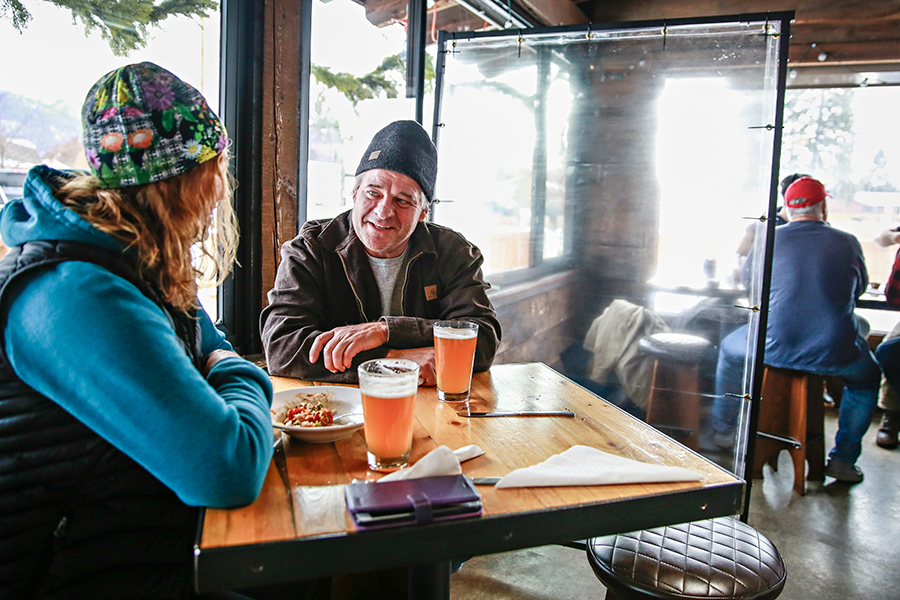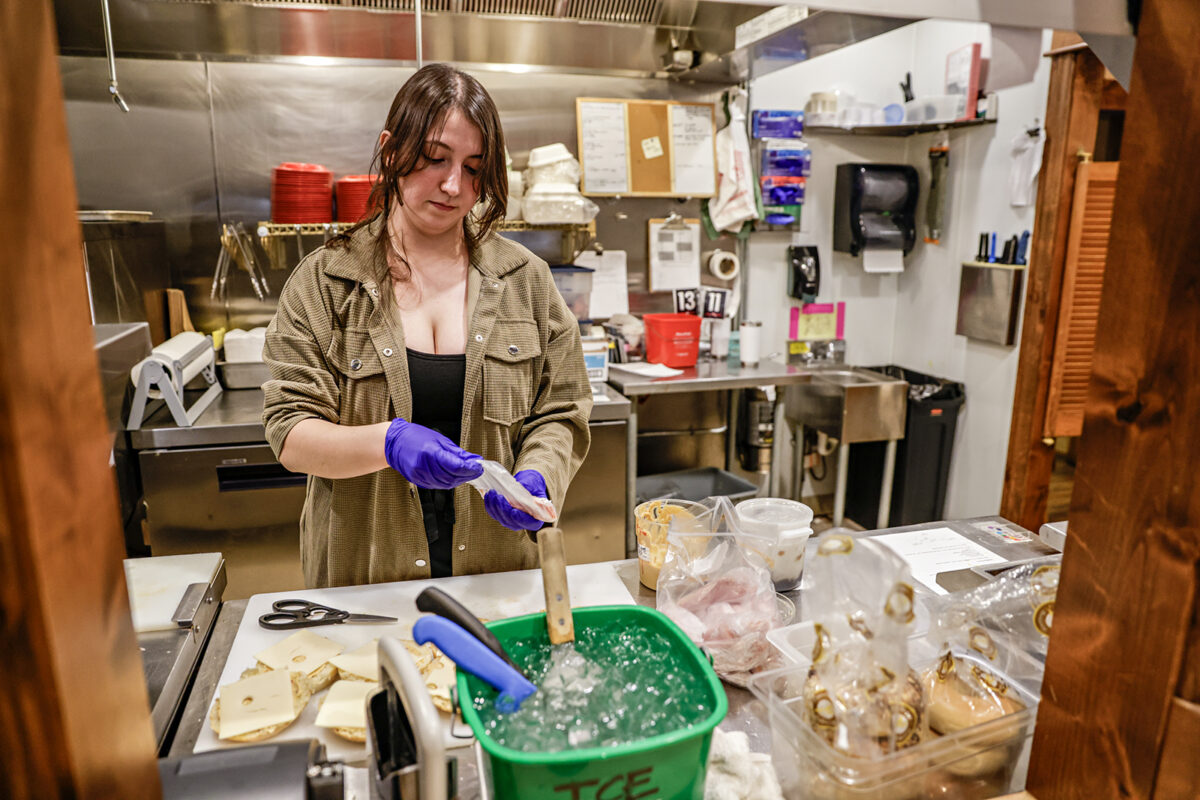Food Industry’s Tight Workforce Slowly Loosens as Flathead Business Owners Adapt
Restaurant managers are seeing more applicants and a lower turnover rate as the unemployment rate slowly rises and employers change their business models to accommodate a shorter staff
By Maggie Dresser
In the winter of 2021 when the shortage of food service workers in the Flathead Valley was at its peak, Backslope Brewing owner Carla Fisher slashed business hours, she cut the menu and she hired every applicant that walked through her door, knowing she might not see them work more than a few shifts.
As recently as last year, Fisher printed 110 W-2 forms despite employing fewer than 50 staff members at one time. More than half of those tax filings were assigned to workers who didn’t stick around, including many who left after a single week.
Now, three years after the workforce shortage crisis crested at Backslope, Fisher says hiring challenges are finally starting to smooth out. She’s noticing a larger pool of applicants and is hiring workers who are more reliable than her previous short-term employees, leading to a lower turnover rate.
“It’s not like it was before where we felt like we needed to put out an ad to get applicants,” Fisher said. “It does feel like there are more options and we don’t have to hire anyone who walks through the door. There was a solid two years where we would hire knowing it wouldn’t work out.”
Fisher is one of many restaurant owners in the Flathead Valley who is noticing that the labor market is beginning to loosen. While she’s relieved that her business is now maintaining a full staff and she’s returned to regular hours, she can’t figure out why hiring has finally begun to stabilize.
“I have no idea,” Fisher said.
In December 2023, Montana’s unemployment rate was 3.2% compared to 2.6% during the same month in 2022. In the years following the pandemic, the unemployment rate went largely unchanged, hovering around 2.5% between November 2021 and August 2023 when it started slowly rising to its current rate, according to Montana Department of Labor and Industry (DLI) data.
At Job Service Kalispell, Manager Laura Gardner says she has heard from business owners across all industries that they are receiving more applications and, while the labor market is still tight, there are indicators to suggest it is loosening.
According to DLI data, there were almost 1,000 job openings last year in the Flathead in mid-February compared to about 750 during the same month in 2024.

But the food service industry grew 5% statewide in 2022 from 41,200 to 43,000 employees, according to the Bureau of Labor Statistics (BLS). The following year in 2023, the workforce shrank by 2% and dropped back down to 42,500.
In the first two quarters in 2023, which is the most recent data available, employment counts were 5% higher compared to the same quarters in 2022. Food services employment has grown by more than 40% since 2012, according to BLS data.
In the Flathead, Gardner said she’s noticed multiple restaurants have closed in the past year, including chains like Subway, Firehouse Subs and Burger King. But other small businesses like Kalispell Brewing Company and the Wich Haus restaurant in Whitefish have also closed. Brooklyn Bagel, which opened in early 2023 in Columbia Falls, lasted less than a year.
At Montana Coffee Traders, which operates multiple locations across the Flathead Valley, managers say the labor pool is returning to pre-pandemic trends and they are also noticing more applicants.
“We’ve had some really great applicants and a better response,” Café Coordinator Jessie Farnes said. “More people are coming to interviews, and we’ve gotten stronger staff members.”
In the spring of 2021, the Coffee Traders’ staff was down 9% compared to before the pandemic, which prompted business leaders to temporarily close the downtown Kalispell location right before a period generally defined by peak tourism season.
Coffee Traders reopened nine months later as the job market began to relax, but Farnes said it wasn’t until last fall that she felt the labor pool really began to stabilize.
But the coffee shop did not fully return to business as usual. In an effort to accommodate the lack of kitchen staff, Farnes said they cut the menu and started preparing more grab-and-go options that didn’t require a line cook. Dine-in options still exist, but the staff doesn’t prepare anything that requires a stovetop, and everyone rotates kitchen duties.
Farnes said that despite the relative ease in hiring, managers plan to keep the menu as it is.
“We’re not looking to bring back the full-service kitchen,” Farnes said. “That is something we were really challenged to staff – line cooks have been much harder to fill.”
Coffee Traders has also adapted to the changing industry with reduced hours at some of their locations. At their coffee roasting hub on U.S. Highway 93 south of Whitefish, hours are now from 8 a.m. to 2 p.m. compared to their previous schedule from 7 a.m. to 5 p.m.
“For staffing, it’s so much easier to function that way,” Farnes said.

With nearly 15 fewer staff members as before the pandemic, managers have adapted Coffee Traders’ business model in order to function, and Farnes said they are in a strong position as the move toward the busy summer season.
In an industry that fluctuates with the seasons, summer always requires significant upsizing in the Flathead Valley, where restaurant owners in particular hire additional workers for the busy months. And while there’s a higher demand for workers during this period, the workforce also grows as students look for jobs during their summer break.
For example, the workforce was almost 20% larger in Flathead County from July through September compared to January through March in 2022, according to DLI data that illustrates the seasonal fluctuations.
At Backslope Brewing, Fisher has taken advantage of initiatives like the J-1 visa program to recruit international exchange students in the summer. Typically used for jobs in Glacier National Park and Whitefish Mountain Resort, it’s allowed Fisher to reach beyond the Flathead Valley to recruit staff.
To house some of her seasonal employees, Fisher even built an annex building with two dormitory-style units for employee housing as many business owners point to a high cost of living and tight housing market that deters applicants.
But with the J-1 visa, students can only stay three months and Fisher is working to secure a different type of work visa that will allow them to stay longer.
“We have felt more hopeful that there are small improvements happening this year than we have felt in the past,” Fisher said. “I’m not sure if it’s going to get any better – this might be what we’re going to have for options and we’re trying to adjust for that possibility. It’s emotionally exhausting of all of us who are in an industry where everybody expects some turnover. But the reasons feel more deep-rooted and out of our control.”